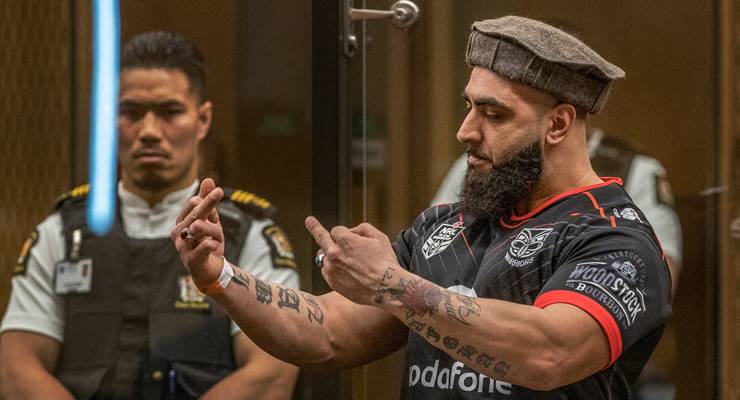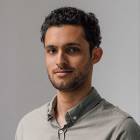
When Ahad Nabi finally faced the man who murdered his father, after hours of harrowing victim testimony, he did not miss.
Dressed in a New Zealand Warriors jersey, and a traditional Afghan hat, Nabi looked the killer dead in the eye, middle fingers raised.
“Coming back to this maggot, I would like to say my 71-year-old dad would have broken you in half if you challenged him to a fight,” Nabi said. “You are weak. A sheep with a wolf’s jacket on for only 10 minutes of your life.
“Your father was a garbage man and you became the trash of society. You deserve to be buried in a landfill.”
On a Friday afternoon in March last year, Nabi’s father had greeted an Australian man at the door of the Masjid Al-Noor in Christchurch.
“Welcome brother,” he said.
The terrorist shot him. And then, in a 15-minute killing spree, live streamed across the internet, he murdered 50 more Muslims at Al-Noor, and then at the nearby Linwood Mosque.
Yesterday, 531 days after the massacre, the terrorist, who had pleaded guilty to 51 counts of murder, 40 counts of attempted murder, and one terrorism offence, was sentenced to life in prison without parole.
It’s the first time such a sentence has been handed down in New Zealand’s history.
A moment of closure
That the terrorist would never leave prison was a conclusion foregone from the moment police officers apprehended him in the streets outside the Linwood Mosque.
This week’s sentencing hearing then, was a formality, a piece of judicial theatre that provided valuable relief and catharsis to the families of the victims.
The court expected to hear victim impact statements from 66 people — family members of the dead, survivors, anyone whose life had been turned upside down by those 15 minutes. Instead, almost 100 people spoke.
Like Nabi, many were defiant and angry, finally given the opportunity to face the person that had robbed them of so much. The terrorist was described as evil, as cowardly, as disgusting.
“You are not actually a human, not even an animal since animals are beneficial to the world,” Mostafa Boztas, a survivor, said.
Sara Qasem spoke through tears about her father Abdelfattah, murdered in the attack: “I want to hear him tell me more about the olive trees in Palestine. I want to hear his voice. My dad’s voice. My baba’s voice.”
“I urge you to take a look around this court room and ask yourself, who exactly is the other here, right now?” Qasem said to the terrorist. “Is it us, or is it you? I think the answer’s pretty clear.”
Others, like Janna Ezat, who lost her son, expressed extraordinary messages of forgiveness.
“I decided to forgive you, Mr Tarrant, because I don’t have hate. I don’t have revenge,” she said directly to the terrorist. “In our Muslim faith we say … we are able to forgive, forgive.”
After hearing Ezat’s statement, the killer seemed to show a flicker of emotion, blinking a tear away from his eye. For most of the four-day hearing, he remained stony-faced and expressionless.
Abdul Aziz Wahabzadah became a hero last March. While at Friday prayers with his four sons, he’d heard gunshots. Ignoring his children’s screams, he’d tried to distract the killer, before chasing him out of the Linwood Mosque with an Eftpos machine, saving dozens of lives.
This week, Wahabzadah faced him again.
“Never forget these two eyes you ran from,” he said.
The killer stays silent
On Wednesday, the terrorist told the court he wouldn’t be giving a statement. That came as a surprise. Initially, he entered a not guilty plea, and planned to run his own defence, prompting fears he would use the trial as a pulpit.
Since the attack, New Zealand has been careful to starve the terrorist’s ideology of oxygen. Prime Minister Jacinda Ardern won’t say his name. In March, when he abruptly announced he’d be changing his plea to guilty, the country breathed a sigh of relief.
What could have been a chance for the terrorist to grandstand, to taunt bereaved families and rile up a coterie of fellow internet fascists became a moment of closure for victims of the attack.
It would be comforting, then, to view this week’s hearing as a kind of coda, a repudiation of Islamophobia and an end to what began that Friday in March 2019.
Perhaps in the terrorist’s decision to plead guilty, his brief moment of emotion in the courtroom was an acknowledgement of remorse, or at the very least, recognition of the reality of a life in prison.
In a pre-sentencing report put together in April, the terrorist said the attack was “unnecessary, abhorrent and irrational”, the product of his “poisoned emotional state”. But he also denied he was racist.
“Nothing good” came from the attack, he said. But this week, the court heard the terrorist had been disappointed. He wanted to target a third mosque, and kill more people.
In many ways, the terrorist got a lot of what he wanted. He brought the repugnant stench of far-right violence to New Zealand, the multicultural paradise at the end of the world where bad things aren’t meant to happen.
He terrorised the country’s small Islamic community — many told the court this week they were still anxious about going to mosque.
And in the sewers of the internet, where the terrorist was radicalised, they call him a saint. They make memes and video games about him. He’s inspired copycat massacres — synagogue shootings in California and Germany, the killing of Latino migrants in El Paso.
The great replacement
When the terrorist released a manifesto online, hours before the attack, it was meant to confuse and disorient a media unfamiliar with the language of the modern internet fascist.
But buried under the irony, memes and the extremely online in-jokes — references to PewDiePie, Candace Owens and forgotten medieval battles — is a fairly standard set of far right beliefs.
The terrorist believed non-white immigrants, and Muslims in particular, were invading the West, leading to a “genocide” of white people.
Ideologically, it’s simply a dialling up of the kind of Islamophobic, anti-immigrant rhetoric that’s become an article of faith for some parts of the political right in the west.
The terrorist’s manifesto was titled The Great Replacement. It’s a reference to a far-right conspiracy theory which claims white people in the West are undergoing demographic genocide through mass migration and declining birth rates.
As absurd as the theory is, it’s never too far from the mainstream.
News Corp’s most widely-syndicated columnist has claimed Australia is being stripped of its identity by a tidal wave of immigrants who are colonising the country and refusing to assimilate.
One of the biggest proponents of the great replacement is Lauren Southern, a far-right Canadian YouTuber. Southern recently moved to Australia, and has started popping up on Sky News after dark programs. Another far-right commentator, Katie Hopkins, who was recently given a run on various Nine programs, has also teased at it.
The terrorist was a creature of the internet’s distant fringes. But the political and media landscape which allowed many of his ideas to enter the mainstream by stealth hasn’t changed.
And even before our political class was too busy with the pandemic, Australia had done little to grapple with the aftermath of the Christchurch attack.
There hadn’t been a concerted effort to combat racism, or a meaningful response to the increasingly insistent warnings from security services about the growing far right threat.
We’ve almost forgotten that the terrorist was one of us. He grew up in Grafton, in the northern rivers region of NSW. Nobody there could have imagined what he would become.
Nearly 18 months on from the attack, the sentencing brought a painful, cathartic moment of release to many in Christchurch.
The terrorist will spend his life in prison. But the culture that created him is still hiding in plain sight.
Note: Since the Christchurch shooting, Crikey has declined to name the terrorist.








Bring the grub home – ‘we’ bred and nurtured him – Dutton’s busy trying to do the same thing in reverse, getting rid of criminals from our shores (even some that were born here).
Ironic that the shooter was, via the ‘The Great Replacement’ theory, if not a symptom, reflecting Anglo governments’ (US, UK and Australia) immigration and cultural policies, especially ‘hostile environment’ for refugees and immigrants; informed by white nationalism not the ‘internet’.
Emoting is not elucidating.
It is not every day, but there trend is there, where a court room emulates FB. There was a time when jurists confined themselves to guiding juries on the facts and perhaps offering a brief synopsis of the main parts of the case prior to sentencing. The moralising was considered the preserve of the clergy.
Nowadays, we are treated (not just in this case) with (1) an assessment of the moral fiber of the guilty party in conjunction with (2) a zoo of “victims” whose statements are not gong to alter the events if they have been recorded accurately. Even the article is an exercise in self-indulgence.
Breivik’s trial (77 v’s 51 killed) was much less indulgent of all parties. As to censorship, we are not permitted to read Tarrant’s ‘manifesto’ for fear of corrupting (presumably) the youth of Christchurch.
By way of contrast, take a look at what Alistair Cook wrote about McVeigh (168 killed) in the style of HL Mencken. “A newspaper is a device for making the ignorant more ignorant and the crazy crazier.”
H.L. Mencken.
“white people in the West are undergoing demographic genocide through mass migration and declining birth rates.
As absurd as the theory is, it’s never too far from the mainstream.”
Sadly this ‘çonspiracy’ theory, as you put it is based in some fact.
Although it abhors me to point this out, it is a consequence of neoliberal doctrine that the poor out-breed the relatively well off. Since Huntington a demographic bubble has been noted in the middle east and to a lesser extent in Africa. To the extent that ‘demographics is destiny’, as he puts it, this would lead to his contention.
What is utter rubbish is the contention that Muslims don’t assimilate. This is more the crux of the matter.
Hope I don’t get trolled and abused for pointing this out to you, and that my political leaning is clear from the above.